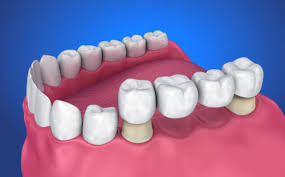A bridge may be recommended if you’re missing one or more teeth. Gaps in your teeth don’t just look unappealing, they can also cause a lot of damage to the surrounding teeth, putting more pressure on them and sometimes straining the jaw. Gaps left by missing teeth eventually cause the remaining teeth to rotate or shift into the empty spaces, resulting in a bad bite. The imbalance caused by missing teeth can also lead to gum disease and temporomandibular joint (TMJ) disorders.

Bridges are commonly used to replace one or more missing teeth. They span the space where the teeth are missing. Bridges are cemented to the natural teeth or implants surrounding the empty space. These teeth, called abutments, serve as anchors for the bridge. A replacement tooth called a Pontic, is attached to the crowns that cover the abutments. As with crowns, you have a choice of materials for bridges. Your dentist can can help you decide which to use based on the location of the missing tooth or teeth, the function of the bridge, aesthetic considerations and cost. Porcelain or ceramic bridges can be matched to the cooler of your natural teeth.
Generally, it takes two appointments to prepare and fit a bridge. During the first appointment the adjacent teeth are trimmed down slightly to accommodate their bridge. An impression is taken of the area and the bridge will be custom made by a specialised lab technician, according to your dentist’s instructions. During this first appointment your dentist will also determine the correct shade for your bridge and a temporary bridge will be put in place to cover the prepared tooth while the permanent bridge is being made.
At your second appointment, the temporary bridge is removed and the new one fitted. Dr. O’Shaughnessy will ensure the fit is comfortable and that you are happy with the appearance.
If you feel that you may require a dental bridge please call us today on 091 525797 to make an appointment and discuss treatment options with Dr. O’Shaughnessy.

